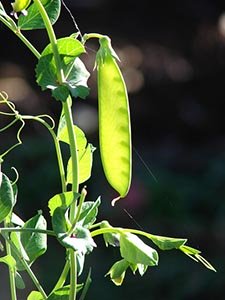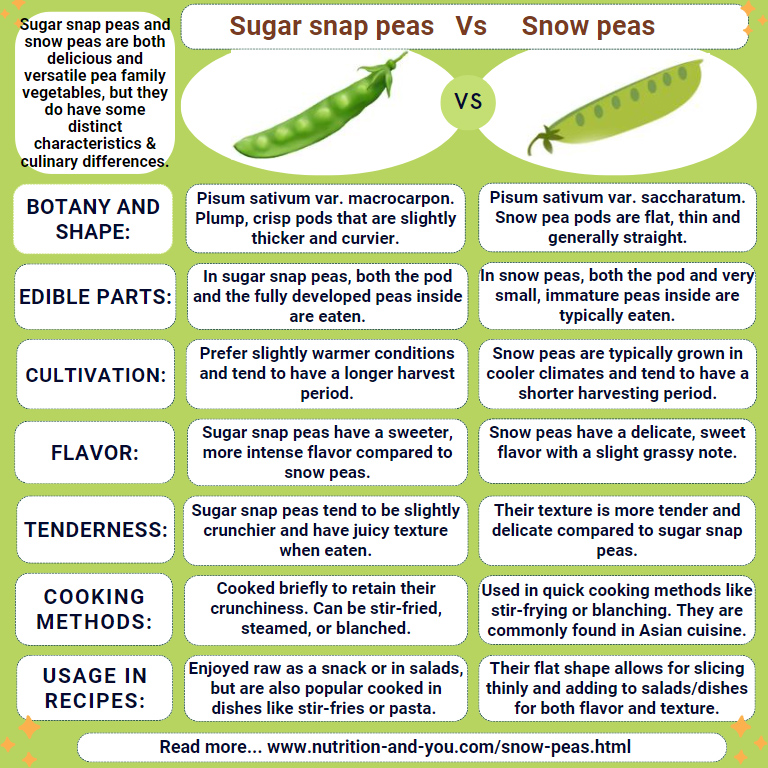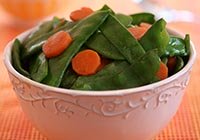Snow peas Nutrition facts
Snow peas, also known as Chinese sugar peas, are immature pea pods in the legume family vegetables, commonly featuring in stir-fried dishes. They primarily differ from the common garden peas in that their whole pod, including peel, is eaten.
Scientific name: Pisum sativum var. macrocarpon. Both sugar snap and snow pea pods are popular as mange tout (which means, "eat all" in French) in France.
 |
| Snap pea on a pea plant. Photo courtesy: Forest and Kim Starr |
Snow peas are cool-season, annual crops. They grow best in sandy, fertile soils. The whole crop takes about 55-70 days from seedling to harvest. Varieties of snow pea cultivars include the dwarf bush type and spreading vine type. Vine cultivars require trellis support to flourish.
Snow peas pods are flat; and possess semi-opaque skin with tiny, flat seeds inside. They differ from sugar snap peas wherein the pods are full, cylindrical with thick, edible skin and round, green seeds inside as in the case of shelling (garden) peas (in shelling peas, however, the skin is inedible).
Snow pea tendrils are furling, tender tips of young pea plants. Employed in cooking and salads, pea tendrils exhibit a pleasant pea flavor.
See the differences between snow peas and snap peas in an infographic:
 |
Health benefits of Snow peas
Snow and snap peas feature almost similar nutrition compositions. They both carry relatively fewer calories than green shelling peas (English peas). 100 g snow pea pods provide just 42 calories against 81 calories of garden peas. Nonetheless, snow pea pods indeed hold more vitamins, minerals, and other plant nutrients than traditional shelling peas.
Since snow peas are eaten along with skin, they carry relatively more fiber than garden peas. Dietary fiber helps in smooth bowel movements and reduces blood cholesterol levels and obesity.
Chinese sugar peas are excellent sources of vitamin C (60 mg/100 g or 100% of DV). Fresh pods carry 1.5 times more vitamin C than garden peas. Vitamin C is a powerful natural water-soluble antioxidant. Vegetables that are rich in this vitamin help develop resistance against infectious agents and scavenge harmful, pro-inflammatory free radicals from the human body.
Fresh snow pea pods are a good source of folic acid. 100 grams of fresh peas provides 42 μg or 10.5% of the recommended daily levels of folates. Folates, along with vitamin B-12, are one of the B-complex groups of vitamins required for cellular DNA synthesis. Research studies suggest that adequate folate-rich foods in expectant mothers would help prevent neural tube defects in newborns.
Likewise in shelling peas, they are also rich in phytosterols, especially ß-sitosterol. Studies suggest that vegetables rich in plant sterols like legumes, fruits, and cereals help lower cholesterol levels.
Chinese sugar peas compose more vitamin K than garden peas. 100 g of fresh peas contain about 25 µg of the daily requirement of vitamin K-1 (phylloquinone). Vitamin K has been found to have a potential role in bone mass-building function by promoting osteoblastic activity in the bone. It has also an established role in Alzheimer's disease patients by limiting neuronal damage in their brains.
Fresh snow peas also contain adequate amounts of antioxidants and flavonoids such as carotenes, lutein, and zeaxanthin as well as vitamin A (provide 1087 IU or 37% of RDA per 100 g). Vitamin A is an essential nutrient that maintains healthy mucosa, hair, and skin. It is also critical for good eyesight. Consumption of natural foods rich in flavonoids offers protection against lung and oral cavity cancers.
Further, snow peas are also a good source of other essential B-complex vitamins such as niacin, pantothenic acid, thiamin, and pyridoxine.
Furthermore, they are a rich source of many minerals such as iron, calcium, copper, zinc, selenium, and manganese.
| Principle | Nutrient Value | Percent of RDA |
|---|---|---|
| Energy | 42 Kcal | 2% |
| Carbohydrates | 7.55 g | 6% |
| Protein | 2.80 g | 5% |
| Total Fat | 0.20 g | 1% |
| Cholesterol | 0 mg | 0% |
| Dietary Fiber | 2.6 g | 7% |
| Vitamins | ||
| Folates | 42 μg | 10.5% |
| Niacin | 0.600 mg | 4% |
| Pantothenic acid | 0.750 mg | 15% |
| Pyridoxine | 0.160 mg | 12% |
| Riboflavin | 0.080 mg | 6% |
| Thiamin | 0.150 mg | 12.5% |
| Vitamin A | 1087 IU | 36% |
| Vitamin C | 60 mg | 100% |
| Vitamin E | 0.39 mg | 2.5% |
| Vitamin K | 25 μg | 21% |
| Electrolytes | ||
| Sodium | 4 mg | <1% |
| Potassium | 200 mg | 4% |
| Minerals | ||
| Calcium | 43 mg | 4% |
| Copper | 0.079 mg | 9% |
| Iron | 2.08 mg | 26% |
| Magnesium | 24 mg | 6% |
| Manganese | 0.244 mg | 10.5% |
| Selenium | 0.7 μgg | 1% |
| Zinc | 0.27 mg | 2% |
| Phyto-nutrients | ||
| Carotene-α | 44 μg | -- |
| Carotene-β | 630 μg | -- |
| Cryptoxanthin-β | 0 μg | -- |
| Lutein+zeaxanthin | 740 μg | -- |
Selection and storage
Fresh snow peas are at their best in spring; however, you can buy them year-round from the markets. Choose fresh, flexible, flat, tender light-green pods.
Avoid dry, wilting, and over-mature pods as they are short of flavor. Similarly, avoid those with surface cuts, cracks, bruises, and discoloration.
Once at home, store them in a perforated plastic cover or paper envelope and place them inside the vegetable compartment of a refrigerator set at high relative humidity so that they remain tender and crispy for about 2-3 days.
Preparation and serving methods
To prepare, wash in cold water and pat dry. Remove green calyx attached at the stem end, and flower remnants at the tips.
Fresh pods are eaten as a whole. Use them early while the pods are fresh and crispy. Snow pea pods feature tough strings which you may need to remove before eating them raw or in the dishes.
Here are some serving tips:
 |
| Teriyaki snow peas and carrots. |
Do not overcook snow peas.
Snow peas are employed in a similar way as snap peas. They commonly feature in East Asian dishes as appetizers, soups, and stir-fries.
Chopped snow peas complement well in raw salads with sprouts, snap peas, shelled garden peas, carrot sticks, yellow beets, etc.
They add a pleasant chewy texture to the stir-fried dishes. Sautee in oil/butter. Add garlic, and onion and mix in rice or noodle dishes.
Gently stir-fry separately before mixing them with other vegetable stir-fries like beans, broccoli, sweet pepper, etc.
Sautéed pea pods served with poultry, and seafood like salmon, tuna, etc.
Safety profile
Snow peas are generally safe to eat in all individuals. They contain negligible amounts of 50 mg/100 of oxalic acid, a naturally occurring substance found in some vegetables, which may crystallize as oxalate stones in the urinary tract in some people. On a comparison note: 100 g of spinach carries 970 mg. Adequate intake of water is, therefore, encouraged to maintain normal urine output to minimize the stone risk. (Medical disclaimer).
Also read ≻≻-
≺≺- Pea shoots nutrition facts and health benefits.
≺≺ Green peas nutrition facts and health benefits.
≺≺ Sugar snap peas nutrition facts and health benefits.
≺≺ Back to Vegetables from Snow Peas nutrotion. Visit here for an impressive list of vegetables with complete illustrations of their nutrition facts and health benefits.
≺≺ Back to Home page.
Further reading:
Refer Stanford School of Medicine Cancer information Page- Nutrition to Reduce Cancer Risk (Link opens in new window).
Oxalate content of selected vegetables (Link opens in a new window).